Author(s): Yakubu Ernest Nwuku, Adeyemi Abel Ajibesin* and Ahmed T Ishaq
Mobile ad hoc network since the mid-90s has been an ongoing area of research [11]. A network that is not built on a mounted access point or does not require a central control is regarded as an Ad hoc network. It does not require a fixed infrastructure to be formed, which utilizes the communication capability of Radio Frequency (RF) and interfaces such as infrared during a decentralized connection framework.
Mobile ad hoc network since the mid-90s has been an ongoing area of research [11]. A network that is not built on a mounted access point or does not require a central control is regarded as an Ad hoc network. It does not require a fixed infrastructure to be formed, which utilizes the communication capability of Radio Frequency (RF) and interfaces such as infrared during a decentralized connection framework [13]. The network is determined by groups of devices that are referred to as nodes with wireless transceivers [21]. Transceivers are capable of building a communication network at whatever point or location the network is being built, as well at whatever time a particular transceiver joins or leaves the network. Numerous times, cell phone devices connect, and without mounted wire structure communication are possible. The Wireless Ad-hoc network as a network with no preexisting infrastructure has helped to achieve network communication, with no cost of establishing a communication infrastructure or having necessary installations. A mobile ad-hoc network usually is characterized by wireless channels, which are shared by several mobile nodes without an established infrastructure of communication or central control. MANET exhibits a dynamic nature, where nodes can move randomly with no fixed routes. As well nodes act as routers and host simultaneously. At a point where nodes are routers, routes to several nodes in the network are usually discovered and maintained [20]. MANET has helped in playing a major role in the area of communication, especially when it applies to the use of wireless networks. Wireless network popularity has been channeled to several applications that have considered factors that include: its ease of installation, its reliability, cost-effectiveness, bandwidth consumption rate, its power consumption rate for each node, security, and most all total network performance [7].
Mobile networks are categorized into two types which include the infrastructure wired-based and ad hoc wireless-based networks. The wired-based infrastructure which is comprises of the LAN, WAN, and MAN amongst others. But focusing more on the ad hoc based wireless networks because of its evolving nature, network communication is made possible even at the mobility of the network nodes. Mobile Ad-hoc Network (MANET) among other examples of ad hoc networks such as WSNs (Wireless Sensor Networks), VANETs (Vehicular Ad-hoc Networks), WMNs (Wireless Mesh Networks), SPANs (SmartPhone Ad-hoc Networks), iMANETs (Internet-based Mobile Ad-hoc Networks) and military or tactical MANETs are wireless, infrastructure-less network [6]. MANETs as a result of its self-configuring nature, a node can enhance communication by a group of wireless nodes (laptops, mobile phones, thin client, etc.). MANET is a peer to peer network that carries out route discovery task. It establishes network communication between a source and destination nodes. Due to its nature of node mobility, its paths are being changed which leads to loss or broken connection between nodes [10]. Nodes act both as a router that forwards packets at the sending end, while the host receives the packets at the receiving end. Within a range of communication, nodes announce their presence to neighbors, which is possible by broadcast. Every communicating node listens and thereafter learns about a neighbor node.
MANET operations differ in network infrastructures like the use of routers, switches, mobile nodes as well other supporting technologies and devices. The most challenge faced in the ad-hoc network which includes frequent topology changes, low power, and asymmetric links [17]. MANET is being categorized into three routing operations. Based on the manner of topology to which the network operates on, such described as the proactive (DSDV, OLSR, etc.), reactive (AODV, DSR, etc.) and hybrid routing (ZRP, WARP, etc.) derived from the first two operations. The routing protocols in packet exchange between two communicating host plays an important role. There exist two basic categories of routing protocols, Proactive Routing Protocol (PRP), the Reactive Routing Protocol (RRP), and as well the third a Hybrid routing protocol which is derived from the first two routing protocols. The Proactive routing protocol is referred to as the destination-based protocol, an improved version of the Internet Link State algorithm. The proactive routing algorithm helps in maintaining routing tables that comprise of information as well as an update for the network node. Each network node runs an update throughout the network to maintain a consistent network due to constant topology change in the network [18]. The Reactive routing protocol is referred to as the table-driven protocol, an improved version of the Internet Link State Distance Vector algorithm. The reactive routing algorithm is characterized by two routing mechanisms; route discovery and maintenance. Route discovery process comprises a route request and route reply, they differ as we move from one protocol to another [2, 18]. This paper proposes to study MANET routing protocols, evaluate and analyze their performance using NS-3, and some other performance metrics. The study objective is to carry out a qualitative study on the performance of the Proactive routing protocol (DSDV and OLSR) and Reactive routing protocol (AOMDV) to be able to establish its best performance level.
Works of experimented on routing protocols AODV, DSDV, AOMDV, and DSR were simulated using NS2. A marine environment of both sparse and dense locations was considered and analysis carried out gave results based on different parameters [14]. The result showed that the AOMDV routing protocol is the most efficient due to its multipath route discovery. Measuring end-to-end delay of AODV, AOMDV, DSDV and DSR against pause time show DSDV exhibit lowest delay of all. In terms of packet delivery ratio and throughput, AOMDV and DSR compared to DSDV is proved the highest and it is observed AODV, DSDV, and DSR provide insufficient packet delivery when AOMDV is put to maximum use.
studied the NS2 network simulator and AWK, performed an analysis of DSR, DSDV, and AODV. Parameter metrics which include Throughput, PDR, and Jitter were put into consideration [1]. From results analyzed and reported from the simulation shows that a significant increase in nodes leads to an increase in average throughput, PDR, and Jitter. The report also shows an outstanding performance of AODV in a network size of above 35 nodes; as well DSR is preferred to smaller networks which show both reactive protocols have great performance over DSDV the proactive protocol.
Analyzed the performance of routing protocol AODV, DSDV, DSR, and AOMDV using the NS2 network simulator. Results show that the dynamic change of network topology gives an unsatisfactory and decreased performance of the four protocols [12]. DSDV amongst others shows not fit for unchanging network topology. Whereas better performance is recorded in terms of PDR, NRL, and E2E delay for DSDV and DSR, also showing better adaptability of 95% during network change in PDR. AODV shows lesser average end to end delay compared to DSR, but in routing, load on DSR is lower than DSDV routing protocol. Both are suitable protocols for a frequently changing network topology. A multi-path routing protocol which is AOMDV has a lower average E2E delay compared to single-path protocols; it only has few aspects that need improvement which is: update and maintenance of backup paths, and multiple paths could at the same time transmit packets.
The research by focused more on speed and node density on the performance of AODV, DSR, DSDV, and OLSR routing protocols, which were evaluated under RPGM (Random Propagation Group Model) Model [16]. Two varying results showed that first the performance of routing protocols at a density from low to high, network performance vary differently based on the network condition. As being observed, due to an increase in mobile nodes, it leads to an increase in PDR which makes the communication more effective compared to nodes in small scale-networks. Secondly aside from large-scale networks, the experiment showed that speed has an associated cost where results showed that AODV has better performance, in terms of both large-scale networks and faster speed over the DSR. Considering DSDV which was a protocol that fits end-to-end delay, which seems to have less performance compared to OLSR for delivered packets but substantial routing overhead is generated.
Researched the effect of the number of packets sent and node size in a network communication reliability. The performance of DSDV, AODV, and OLSR which are popular routing protocols, analyzed based on packet delivery ratio, throughput, and total energy consumption using Network Simulator 3 [19]. The result shows AODV with performance best at low traffic when traffic is medium DSDV shows the best performance and at a high traffic rate OLSR is best rated. In terms of energy consumption, DSDV and OLSR outperform AODV. At high traffic, OLSR shows better result than DSDV though have the same performance. Throughput or AODV has the best performance, whereas OLSR and DSDV show quite the same result but OLSR still shows high throughput than DSDV at high nodes and number of packets, which still outperforms AODV
The performance of multi-hop wireless ad-hoc routing protocol in an outdoor network was analyzed by [8]. The simulation of four routing protocols which are AODV, DSDV, OLSR, and DSR was analyzed using NS3 an open-source implementation discrete event simulator. A simulation of 10 by 10 static grid topology scenario was established, with ON-OFF packet traffic. The result showed DSR performance as best to the majority of performance metrics in terms of hop count, PLR, OWD, and throughput. OLSR performs well in the same condition, unlike AODV and DSDV that has shown a 45% packet loss rate. DSR’s well performance is due to its route caching mechanism because a constant route discovery is not necessary for routes to the same destination. Due to high packet loss caused by increased route discovery, it causes a queue in the number of packets, at the process packets, get dropped in the case of AODV. Despite DSDV’s proactive ability, results show it has the highest average delay, which probability of high packet loss is relative which is the same with OLSR, but OLSR has an effective way of handling the problem. AODV a classical reactive approach in intensive route breakages shows low tolerance which is inapplicable to the said model. OLSR and DSDV are considered applicable, as delay metric is of less importance. Whereas the DSR with its overall result at a close optimum level but has a drawback of high jitter that could harm some network applications.
Based on our review, most researchers have carried out extensive research on MANET but haven’t looked into the approach proposed, with which this paper will be more concern with evaluating the behavior of the proactive (i.e DSDV and OLSR) and reactive (i.e AOMDV) routing protocols, putting into consideration the varying number of mobile nodes (20, 40, and 60), performance metrics (Average Throughput, Average End-to-End Delay and Average Energy Consumption) and a different simulation approach as when it is simulated as a real-time scenario on a network using NS3.
In this chapter, we present and explain the methodology of the study. The simulation tools used for simulation and various metrics involved in the performance evaluation of MANET proactive and reactive routing protocol are discussed. The performance parameters considered will also be discussed afterward in the simulation setup.
For this study, Network Simulator 3 (NS3) software will be used for our simulation. NS3 is a discrete-event network simulator in which architecture is modeled after the predecessor tool network simulator 2 (NS2) licensed GNU GPLv2, which is also available for research and development (Atif et al., 2013; Gupta et al., n.d.). NS3 is a new simulator, a synthesis of several predecessor tools, which includes NS2, Georgia Tech Network Simulator (GTNetS), and YANS simulator. NS3 software prioritizes the use of standard input and output file formats for packet trace analyzers. Users are also provided links to GNU Scientific Library or IT++ as external libraries. It provides an ease of debugging as well as better alignment with current languages. By architecture, the NS2 predecessor tool was the mixture of object-oriented Tcl (OTcl) and C++ in which proved hard to debug and Tcl became unfamiliar. The design of NS3 has purely based on C++ based models for ease of debugging and performance, and a Python-based scripting API integrated with other Python-based programming models. NS3 allows users to freely write simulations as either C++ main () programs or Python programs [5].
The following metrics were considered for the analysis.
As parameter metrics in measuring ad-hoc network performance, throughput measures the successful average number of packets delivered per unit time over a communication path. It can also be calculated as the number of bits delivered per second. It is measured in bits per second (bits/sec) or kilobits per second (kbps) [4]. Mathematically, Throughput (S) can be represented as shown in Eq. 1:

The Average End-to-End delay is the average time including all possible delays that are generated by queuing at interface queue, the process of buffering during routing discovery, propagation and transfer times of data packets, and delays retransmission of data packet from source node until packet is delivered to the destination node [15]. Mathematically, Average End-to-End Delay can be represented in Eq. 2:

Antennas for wireless communication need more energy because they are usually omnidirectional, the energy of links or communicating nodes as a basis of the amount of calculated energy needed for modulation. The energy consumption model is defined by three parameters: initial energy, transmission energy (txPower), and reception power (rxPower). Computing the amount of energy consumed during transmission, transmission power (txPower) should be multiplied by the time required to transmit packets [9]. For the calculated average energy consumption (AEC) represented mathematically, as shown in Eq. 3 is the proportion sum of entire energy used by every node to an entire number of nodes.

The proposed work is implemented using the NS3 simulation tool. We attempt to compare all three routing protocols using the same parameter set up as shown in Table 1. For all the simulation, the same movement model was used; the number of traffic sources was set to 20, 40, and 60 nodes and at a 1000m x 1000m topology boundary.
Table 1: Simulation parameters used in performance evaluation| Parameter | Value |
|---|---|
| Topology generated/Nodes | 20, 40, 60 |
| Simulation Time/Second | 200sec |
| MAC | Ad-hoc WiFi Mac |
| MAC Standard | 802.11b |
| Mobility Model | Constant Speed Propagation Delay |
| Node Speed | 20ms |
| Propagation Model | Random Way Point Mobility Model |
| Topology Boundary Area | 1000m x 1000m |
| Application | TCP |
| Routing Protocol | DSDV, OLSR, AOMDV |
The network logics of DSDV, OLSR, and AOMDV were implemented at a different number of nodes (20, 40, and 60). The Network Animator (NetAnim) for all the network topology generated is displayed in Fig 1, 2, 3.
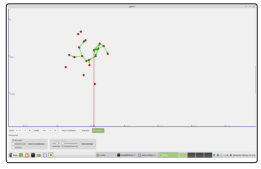
Figure 1: NetAnim 20 Nodes
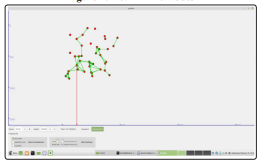
Figure 2: NetAnim 40 Node

Figure 3: NetAnim 60 Nodes
Simulation results generated from python trace analyzers were obtained and categorized. During the simulation, all network activities were logged into NS3. Python scripts were used to extract useful information from trace files. The evaluation was carried out using three performance metrics: average Throughput, Average End-to-End Delay, and Average Energy Consumption. Tables 2, 3, and 4 show simulation results that compare the performance of DSDV, OLSR, and AOMDV mobile ad-hoc network routing protocols. Table 2 shows the result for Average Throughput, Table 3 shows the result for Average End-to-End Delay whereas Table 4 shows the result for Average Energy Consumption.
| Node | DSDV | OLSR | AOMDV |
|---|---|---|---|
| 20 | 1.064929549 | 2.099288804 | 1.835093767 |
| 40 | 1.072912982 | 1.063815164 | 0.866401337 |
| 60 | 1.00764548 | 1.223753628 | 1.283659553 |
| Average | 1.048496004 | 1.462285865 | 1.328384886 |
| Node | DSDV | OLSR | AOMDV |
|---|---|---|---|
| 20 | 0.000474819 | 0.001241479 | 0.287524641 |
| 40 | 0.030486621 | 0.000806558 | 0.208735929 |
| 60 | 0.029817267 | 0.019781354 | 0.220438283 |
| Average | 0.020259569 | 0.007276463 | 0.238899618 |
| Node | DSDV | OLSR | AOMDV |
|---|---|---|---|
| 20 | 0.154973905 | 0.155744571 | 0.155606095 |
| 40 | 0.158768659 | 0.159620707 | 0.159442951 |
| 60 | 0.160088344 | 0.160360328 | 0.15982441 |
| Average | 0.157943636 | 0.158575202 | 0.158291152 |
The results obtained are discussed below.
Table 2 data presents the Average Throughput of all observed routing protocols with varying nodes (20, 40, and 60). It is at 20 nodes OLSR has the highest throughput performance over the other two protocols DSDV and AOMDV, followed by AOMDV which is next in terms of throughput performance and DSDV has the least average performance. At 40 nodes DSDV and OLSR exhibit similar throughput performance except for DSDV which have a slight increase in performance than OLSR and thus, AOMDV has the least performance. At 60 nodes, AOMDV has the highest throughput performance then followed by the OLSR and DSDV the least performance all shown in Fig. 4 respectively. The throughput as presented in Fig 4 which was varied at several nodes shows the dominance of OLSR in terms of performance gain over DSDV and AOMDV, which means OLSR performs better at 20 nodes but at nodes greater than 20 there is a decrease in performance. While as shown in Fig. 5, at an average throughput performance OLSR has the highest throughput, then AOMDV, and lastly DSDV which is the least.
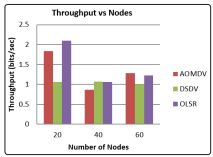
Figure 4: Throughput vs Nodes
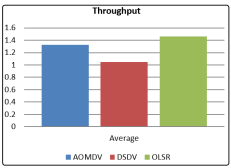
Figure 5: Average Throughput
Table 3 presents the average End-to-End Delay of all the observed protocols at a varying number of nodes (20, 40, and 60). AOMDV shows it has the highest average End-to-End Delay at 20 numbers of nodes over DSDV and OLSR, OLSR which is seen to be next in performance and DSDV having the least End-to-End delay. At 40 nodes, AOMDV still has the highest performance, but this time DSDV is next highly performed then OLSR. As well as at 60 nodes AOMDV still dominates the rest, DSDV being the next and OLSR the least all shown in Fig. 6 respectively. As result shown in Fig. 7, DSDV and OLSR which are proactive perform better than AOMDV the reactive protocol in terms of average End-toEnd delay, in fewer nodes (<40) OLSR has the least End-to-End delay making it of better performance compared to DSDV at a greater number of nodes (>20) and then AOMDV.
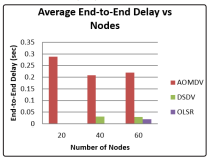
Figure 6: Average End-to-End Delay vs Node
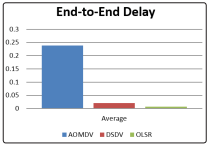
Figure 7: Average End-to-End Delay
Table 4 presents the Average Energy consumption of all the observed protocols at varying nodes (20, 40, and 60). Although the three routing protocols seem to have a regular increase in energy consumption rate as the number of nodes is increased. At 20 nodes DSDV has the least average energy consumption followed by AOMDV and then OLSR which has the highest energy consumption rate. At 40 nodes, the least energy-consuming protocol is still DSDV then AOMDV and OLSR but at 40 nodes, the consumption rate gets an increase. At 60 nodes, this point AOMDV has the least energy consumption rate, then followed by DSDV and OLSR having the highest as the number of nodes keeps increasing. All shown in Fig. 8 respectively the trend depicts increased energy consumption as the number of nodes tends to increase. As shown in Fig. 9, it shows clearly DSDV is regarded as the least energy-consuming routing protocol, then AOMDV as the next least energy-consuming protocol and OLSR which has less energy consumption only at fewer nodes due to its operation in less stressful environments, but consumes more energy at a larger number of nodes (i.e nodes 40 and greater).
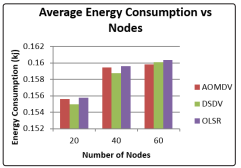
Figure 8: Average Energy Consumption vs Nodes
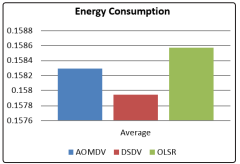
Figure 9: Average Energy Consumption
In this research, an analytical study on the performance evaluation of MANET proactive and reactive routing protocols, under a varying number of mobile nodes was carried out. From this study, we conclude that routing protocols play a prominent role in this new modern-day of telecommunications, as well as the Internet communication between several users thereby ensuring a greater impact of development both services rendered and its users. Different routing protocols are characterized by their unique attributes according to the network scenario they are applied to. The reliability of a particular network scenario is determined by a suitable routing protocol that best fits and could provide efficient results in terms of network operation. The proactive and reactive routing protocols are categorically the two routing protocols that have been analyzed; therefore, each plays its unique role and has its application usage.
The simulation study adopted in this research consists of three routing protocols DSDV, OLSR and AOMDV, which were deployed over to analyze their behavior under three parameters, average throughput, and average end-to-end delay and average energy consumption. The motivation was to check the performance of the mentioned routing protocols in MANET according to outlined performance metrics. It has been a major issue when it comes to selecting an efficient and reliable routing protocol. In this simulation work, results were gotten which includes result tables and simulation graphs in which the average statistical data were concluded.
From the above simulation Fig. 6, 7, and 8 the routing protocol behaviors at different mobile nodes ranging from 20, 40, and 60 all showed results of the analysis carried out, it can be seen which routing protocol has better performance over another.
The study of this proactive and reactive routing protocols shows that OLSR is better in a mobile ad-hoc network according to our research carried out and simulation results presented as also compared to DSDV but lesser which tells that proactive protocols have better performance in the network, although its performance may vary at other networks. At the end of this study, a conclusion is drawn that simulation and analysis of routing protocol performance do vary at different network scenarios.
